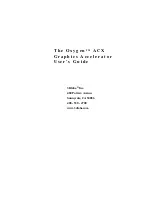
5-22 Operation
MN1903
5.7 Servo axis - tuning for velocity control
Drives designed for velocity control incorporate their own velocity feedback term to provide
system damping. For this reason, KDERIV (and KVEL) can be set to zero.
Correct setting of the velocity feed forward gain KVELFF is important to get the optimum
response from the system. The velocity feed forward term takes the instantaneous velocity
demand from the profile generator and adds this to the output block (see Figure 11).
KVELFF is outside the closed loop and therefore does not have an effect on system stability.
This means that the term can be increased to maximum without causing the motor to oscillate,
provided that other terms are setup correctly.
When setup correctly, KVELFF will cause the motor to move at the speed demanded by the
profile generator. This is true without the other terms in the closed loop doing anything except
compensating for small errors in the position of the motor. This gives faster response to
changes in demand speed, with reduced following error.
5.7.1 Calculating KVELFF
To calculate the correct value for KVELFF, you will need to know:
H
The speed, in revolutions per minute, produced by the motor when a maximum demand
(+10V) is applied to the drive.
H
The setting for
LOOPTIME
. The factory preset setting is 1ms.
H
The number of encoder lines for the attached motor. Baldor BSM motors use either 1000
or 2500 line encoders.
The servo loop formula uses speed values expressed in
quadrature counts per servo loop
. To
calculate this figure:
1. First, divide the speed of the motor, in revolutions per minute, by 60 to give the number of
revolutions per second. For example, if the motor speed is 3000rpm when a maximum
demand (+10V) is applied to the drive:
Revolutions per second
=
3000 / 60
=
50
2. Next, calculate how many revolutions will occur during one servo loop. The factory preset
servo loop time is 1ms (0.001 seconds), so:
Revolutions per servo loop
=
50 x 0.001 seconds
=
0.05
3. Now calculate how many quadrature encoder counts there are per revolution. The NextMove
PCI counts both edges of both pulse trains (CHA and CHB) coming from the encoder, so for
every encoder line there are 4 ‘quadrature counts’. With a 1000 line encoder:
Quadrature counts per revolution
=
1000 x 4
=
4000
4. Finally, calculate how many quadrature counts there are per servo loop:
Quadrature counts per servo loop
=
4000 x 0.05
=
200
Summary of Contents for NextMove PCI
Page 1: ...NextMove PCI Motion Controller MOTION CONTROL Installation Manual 3 02 MN1903...
Page 2: ......
Page 6: ...iv Contents MN1903...
Page 16: ...3 4 Basic Installation MN1903...
Page 42: ...4 26 Input Output MN1903...
Page 57: ...Operation 5 15 MN1903 Figure 11 The NextMove PCI servo loop...
Page 74: ...5 32 Operation MN1903...
Page 90: ...A 8 Accessories MN1903...
Page 91: ......
















































